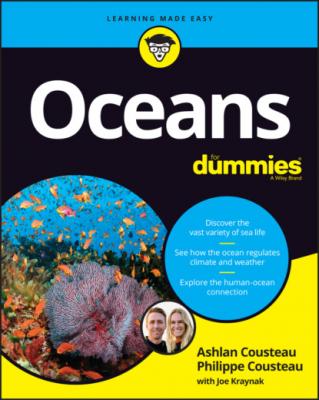Oceans For Dummies. Joseph Kraynak
Читать онлайн.| Название | Oceans For Dummies |
|---|---|
| Автор произведения | Joseph Kraynak |
| Жанр | География |
| Серия | |
| Издательство | География |
| Год выпуска | 0 |
| isbn | 9781119654452 |
The first complex animals with mineralized remains formed.
The evolution of flexible limbs became the first “arms.”
The first real predators evolved, such as anomalocaris, a shrimplike creature that hunted worms and other soft bodied animals.
Pikaia (see Figure 3-2) and haikouella grew a flexible rod of cartilage to swim, becoming the ancestors of the vertebrates (animals with backbones).
Trilobites, one of the first arthropods (think spider or crab), appeared.
More complex food webs began to develop.
This period ended with the Cambrian-Ordovician Extinction event, due to a possible crash in oxygen levels in the ocean.
Photo by Nobu Tamura. Licensed under CC BY-SA 2.0
FIGURE 3-2: Artist rendering of a Pikaia with a jellyfish.
The Ordovician period
The Ordovician period (from 485.4 to 443.8 million years ago) changed the face of the world. Rapid seafloor spreading resulted in high sea levels, creating new environments and habitats as well as a rapid diversification of life, including the Great Ordovician Biodiversification event. During this period:
True fish appeared (see Chapter 12), the ostracoderms — jawless fish with bony plates.
Ocean life also consisted of graptolites (which lived in colonies sharing the same skeleton), corals, crinoids (think starfish, sea urchins), brachiopods (clams, oysters), the surviving trilobites, gastropods (snails, slugs), cephalopods (squid, octopus), and red and green algae.
Also swimming around during this period are six-meter-long shelled cephalopods called cameroceras (imagine a squid in a long pointy shell, three times longer than you are tall).
The first land plants started to grow, resembling moss. These plants sucked up a lot of carbon dioxide helping to create an ice age, which is basically the opposite of what is happening now — global warming as a result of a massive release of greenhouse gasses, including carbon dioxide (thanks to human activities).
The Ordovician-Silurian Extinction event occurred, wiping out 86 percent of marine species, including some trilobites and cephalopods. (These periods never seem to end well.)
The Silurian period
The Silurian period (from 443.8 to 419.4 million years ago) was a time of stable climate (well, relative to earlier periods), but warmer, causing sea levels to rise again. So fun. During this period:
Early vascular plants appear, and fungi move onto land. This is also possibly when spiders and centipedes show up.
Fish split into bony fish and cartilaginous fish. The cartilaginous fish eventually become sharks and rays.
The bony fish split into two groups — lobe-finned and ray-finned. The ray-finned fish give rise to modern fish, while the lobe-finned fish evolve into tetrapods (generally four-limbed creatures), which later evolve into amphibians, reptiles, mammals, and birds.
The first evidence appears showing coral reefs expanding and developing.
Brachiopods (like oysters) are very common, but other organisms continue to thrive, including trilobites, echinoderms, cephalopods, and gastropods.
Ostracoderms (jawless fish) diversify, and the first freshwater species evolves.
Sea scorpions called eurypterids (sort of like horseshoe crabs) evolve, and holy moly are they ever terrifying! (See Figure 3-3.)
Fish get jaws, although it will be about 430 million more years before Jaws, the book and movie, become popular entertainment.
Photo by Obsidian Soul with background by Dimitris Siskopoulos. Licensed under the CC BY 4.0.
FIGURE 3-3: Artist rendition of a sea scorpion (eurypterid).
The Silurian period ended in a series of smaller extinction events, likely caused by a drop in sea-level, which the bottom-dwellers couldn’t handle; mostly cephalopods went extinct.
The Devonian period
The Devonian period (from 419.2 to 358.9 million years ago) marks the era when fish took over the seas. Sea levels were higher, covering much of the land, creating vast shallow coastal areas. During this period:
Common animals are rugose corals, crinoids, and jawless fish.
Early sharks emerge (hey girl, hey!)
Placoderms (jawed, armored fish) dominate and occupy both sea and freshwater environments. Some are predators, others are filter feeders.
Lobe-finned fish relatives develop the ability to move along shorelines (on land), like mudskippers today. 379 million years ago, their descendants finally became land dwellers — tetrapods (meaning four legs). The proof? They left footprints.
Amphibians evolve.
Coelacanths (large, plump, lobe-finned fish) evolve and are still around to this day. See Chapter 12 for a cool photo.
The first spiders and other insects appear, this time for sure.
Crinoids, corals, brachiopods, ammonite relatives, and ostracoderms are present and accounted for. Ammonites have a shell like a snail and a body like a squid.
The first complex land ecosystems begin to develop.
The Late Devonian Extinction marked the end of the party, occurring in at least two phases due to drops in oxygen levels in the ocean. Even the trilobites and placoderms had a tough time surviving this mass extinction.
The Carboniferous period
The Carboniferous period (from 358.9 to 298.9 million years ago) was marked by a warm, humid climate with loads of oxygen and lots of forests, making this period famous for its swamps. Some animals called amniotes, began laying eggs with shells on land; these are the early ancestors of reptiles, birds, and mammals. But it wasn’t all about them; arthropods (insects) also began to take over the land — think giant dragonflies the size of seagulls.
Meanwhile, back in the ocean:
Sharks begin their massive diversification with about 45 families emerging.
Coral reefs flourish again, and invertebrate marine animals are common. Foraminifera (single-cell organisms with shells) become common.
Nautiloids emerge, and while they represented a very diverse group of predators at the time, today only their ancestor the Nautilus remains (see Figure 3-4).
